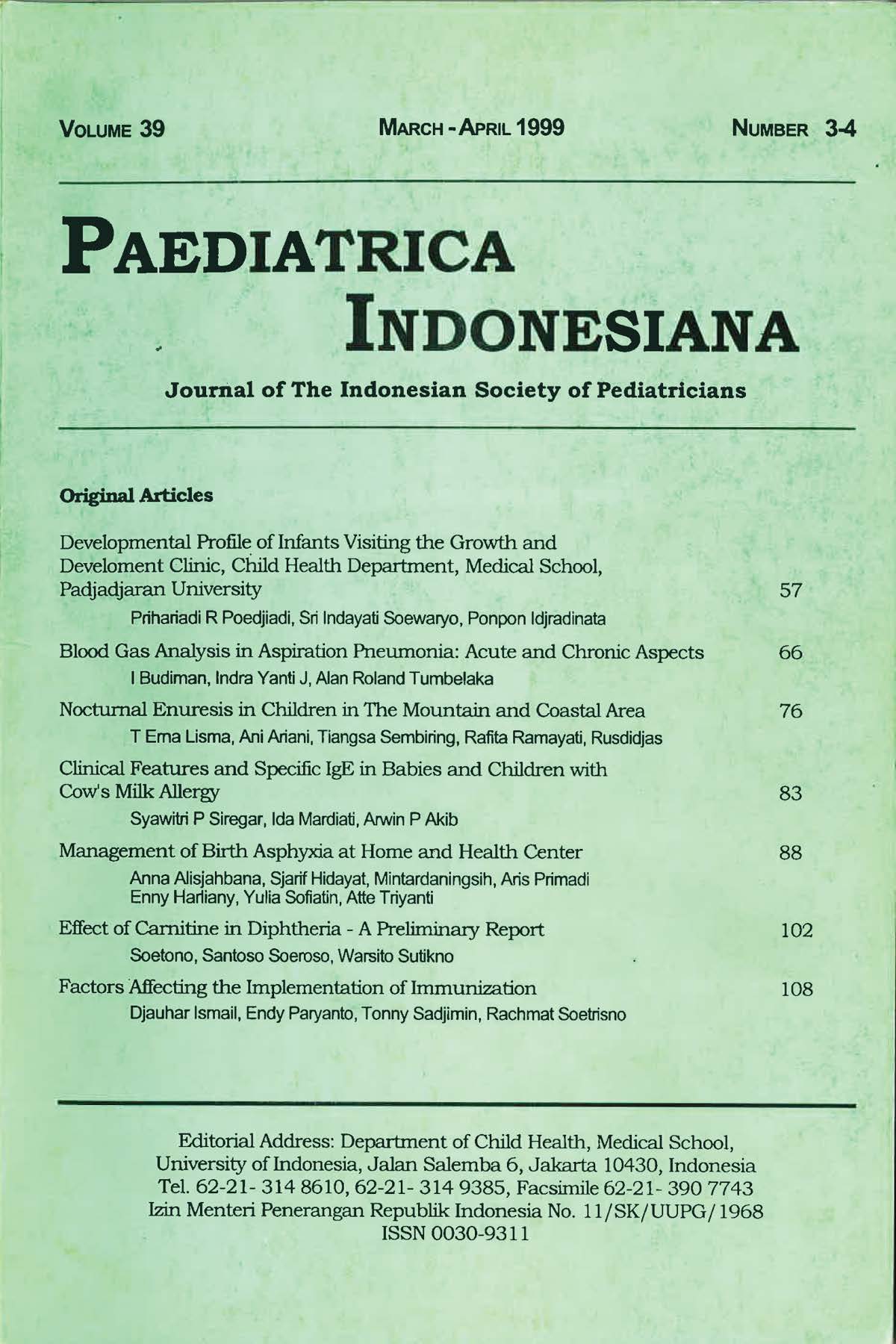Blood Gas Analysis in Aspiration Pneumonia: Acute and Chronic Aspects
DOI:
https://doi.org/10.14238/pi39.3-4.1999.66-75Keywords:
blood gas analysis, aspiration pneumoniaAbstract
A retrospective cross-sectional study, was conducted between January
1st 1991 until December 31st 1996, to find out the acute and chronic aspects of
changes of blood gases in aspiration pneumonia A sample of all aspiration pneumonia patients hospitalized in Cipto Mangunkusumo Hospital, Jakarta, between January 1st, 1991 to December 31st, 1996 was selected (n=l67). Data were obtsined from the medical records. Only 65 patients were included in the srudy, from which 32 (49.2%) were males and 33 (50.8%) were females. Changes in blood gllS analysis observed were decrease in PaO, (30.8%), normal PaC02 (30.8%) and decrease in PaC02 (60%) and abnormal oxygen saturation (80% in acute cases, and 11.1% an chronic cases). The prevalence of acute aspiration pneumonia was 30.8% and chronic aspiration pneumonia was 69.2%. Tachypnea, cyanosis, tachycardia and prolonged expiration were more prominent in tbe acute aspiration pneumonia as well as oxygen saturation which was more dominant parameter. We concluded that with blood gllS analysis we would understand the natwal course of the disease whether acute or chronic.
References
2. Exarhos NO, Logan WD, Abbott OA, Hatcher C. The importance of pH and volume intracheobronchial aspiration. Dis Chest 1965; 47:167-9.
3. Awe WC, Fletcher WS, Jacob SW. The pathophysiology of aspiration pneumonitis. Surgery 1966; 60:232-9.
4. Cameron JL, Mitchell WH, Zuidema GO. Aspiration pneumonia; clinical outcome following documented aspiration. Arch Surg 1973; 106:49-52.
5. Wynne JW, Modell JH. Respiratory aspiration of stomach contents. Ann Intern Med 1977; 87:466-74.
6. Cameron JL, Zuidema GO. Aspiration pneumonia; magnitude and frequency of the problem. JAMA 1972; 219:1194-6.
7. Mcintosh, Campbell AGM. Meconium aspiration syndrome. Dalam: Mcintosh, Campbell AGM, Ed. Textbook of pediatrics; edisi ke-4. Philadelphia: Saunders, 1992; 208-10.
8. Vidyasagar 0, Feh TF, Harris V, Pildes RS. Assisted ventilation in infants with meconium aspiration syndrome. Pediatrics 1975; 56:208-12.
9. Brook I. Percutaneous transtracheal aspiration in the diagnosis and treatment of aspiration pneumonia in children. J Pediatr 1980; 96:1000-4.
1 0. Oarwis D. Analisis gas darah pada kegagalan pernapasan akut. Dalam: Hassan R, Kasim YA, Markum HAH, penyunting. Penatalaksanaan kegawatan pediatrik: beberapa
rnasalah dan penanggulan. Jakarta, 1981; 47-56.
11. Shapiro BA, Harrison RA, Trout CA. Oxygenation. Oalam: Shapiro BA, Harrison RA, Trout CA, penyunting. Clinical application of respiratot;y care. Chichago, 1975; 111-26.
12. Carman CT, Young DA. Clin.ical applications of pulmonary function tests. Dalam: Hinshaw HC. Penyunting. Diseases of the chest, edisi ketiga. Philadelphia, 1969; 95-127.
13. Arms RA, Dines DE, Tinsman TC. Aspiration pneumonia. Chest 1974; 65:136-9.
14. Killian A, Guthrie RD, Balsan MJ. Aspiration syndromes. Oalam: Fuhrman BP, Zimmerman JJ, penyunting. Textbook of pediatric critical care; edisi pertama. St Louis: Mosby YearBook, 1992; 437-9.
15. Porembka DT, Kier ADVM, Sehlhorst SAHT, Boyce S, Orlowski JP, Davis Kjr. The pathophysiologic changes following bile aspiration in a porcine lung mod.e.t Chest 1993; 104:919-24.
16. Zweegman S, Koeleman HGM, VanKralingen KW, Postmus PE. Pneumonia after aspiration of grit. Chest 1994; 106:265-7.
17. Potts RG, Zaroukian MH, Guerrero PA, Baker CORN. Comparison of blue dye visualization and glucose o:lcidase test strip methods for detecting pulmonary aspiration of enteral feedings in intubated adult. Chest 1993; 103:117-21.
18. Vila P, Canet J, Melero A, et al. Acid aspiration prophylaxis in morbidly obese patients : famotidine vs. ranitidine. Anasthesia 1991; 46:967-9.
19. Torres A, Serra-Batlles J , RosE, dela Bellacasa JP, Cobos A, Lomena F, Rodriguez-Raisin R. Pulmonary aspiration of gastric contents in patients receiving mechanical ventilation: the effect of body position. Ann lnt Med 1992; 116:540-3.
20. Vanner RG, Pryle JPO, Reynolds F. Upper oesophageal sphincter pressure and the effect of cricoid pressure. Anaesthesia 1992; 47:95-100.
Downloads
Published
How to Cite
Issue
Section
License
Authors who publish with this journal agree to the following terms:
Authors retain copyright and grant the journal right of first publication with the work simultaneously licensed under a Creative Commons Attribution License that allows others to share the work with an acknowledgement of the work's authorship and initial publication in this journal.
Authors are able to enter into separate, additional contractual arrangements for the non-exclusive distribution of the journal's published version of the work (e.g., post it to an institutional repository or publish it in a book), with an acknowledgement of its initial publication in this journal.
Accepted 2017-11-16
Published 1999-04-30


















